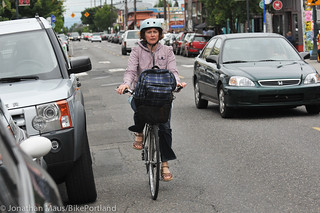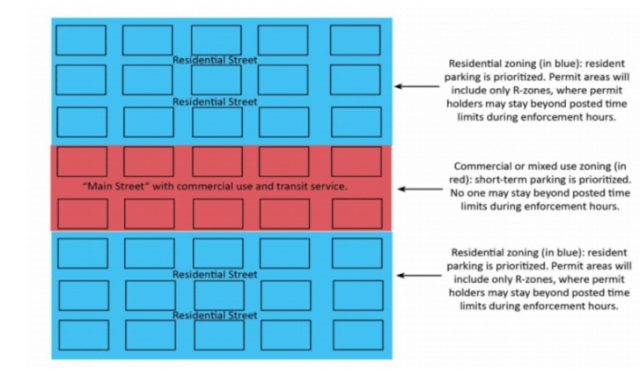
(Photo: J. Maus/BikePortland)
(Publisher’s note: This week we’re excited to highlight a few of the projects created by students in Portland State University’s Traffic and Transportation course. As we reported in a profile earlier this year, the class has had a vast impact on Portland in numerous ways by churning out over 1,200 smart and inspired graduates since 1991. We worked with class assistant Rebecca Hamilton (a graduate herself who now works at Metro) to share three of the projects that will be presented by students in class later this week.)
Parking Benefit Districts – a project by CT (who requested anonymity)
Parking plays a big role in how places develop. And as we all know, the amount of parking in a neighborhood or commercial district directly impacts how it feels to walk and roll through. CT points out that cities can also choose to manage parking in a way that creates revenue for safety projects and programs that encourage non-driving travel options. Here’s more about CT’s work on what are known as “parking benefit districts.”
What’s your big idea?
Parking Benefit Districts. For neighborhoods that implement residential and other types of parking permits and parking meters, they should get most (51-100%) of the parking revenues back to the neighborhood. The parking revenues can be used for transportation demand management (e.g. transit or bikeshare passes) and/or small infrastructure improvements (e.g. crosswalks, flashing beacon, curb extensions, etc). The goal is to manage on-street parking resources and enhance safety and transportation choices for neighborhoods.
Here’s what that might look like conceptually…
Advertisement

What steps are you taking to make it happen? Have you made any progress towards your goal?
Many of my neighbors are interested in parking management tools to address parking spillover from new development and commercial corridors. My project will depend on the long-waited residential permit program. So the first step is having a residential permit program in place. Then I will talk to neighborhood residents and businesses and gather their support for a parking benefit district. I will also talk to PBOT staff to understand how a parking benefit district may be set up in a neighborhood like Boise (in northeast Portland). Lastly, I want to help the neighborhood to work with PBOT to develop consensus on what kind of improvements and programs can be paid for by parking revenues.
What have you learned about trying to make a change in your community? Has anything surprised you?
People don’t like change, even if it’s for the better. The key is helping people understand the trade-offs change can bring. No one likes to pay for parking, but if that means it can help making our neighborhood safer, more walkable, and less congested with cars, people might be willing to do it. One thing that surprised me is that There is an exceptional level of passion and activism among our residents. In Portland, you don’t need to have a planning or engineering background to have great ideas for improving your neighborhood and the city.
This is the first in a series. Stay tuned tomorrow for Amy Wren’s project that focuses on improving biking and walking routes to Bridger Elementary School.
— Jonathan Maus, (503) 706-8804 – jonathan@bikeportland.org
BikePortland is supported by the community (that means you!). Please become a subscriber or make a donation today.


